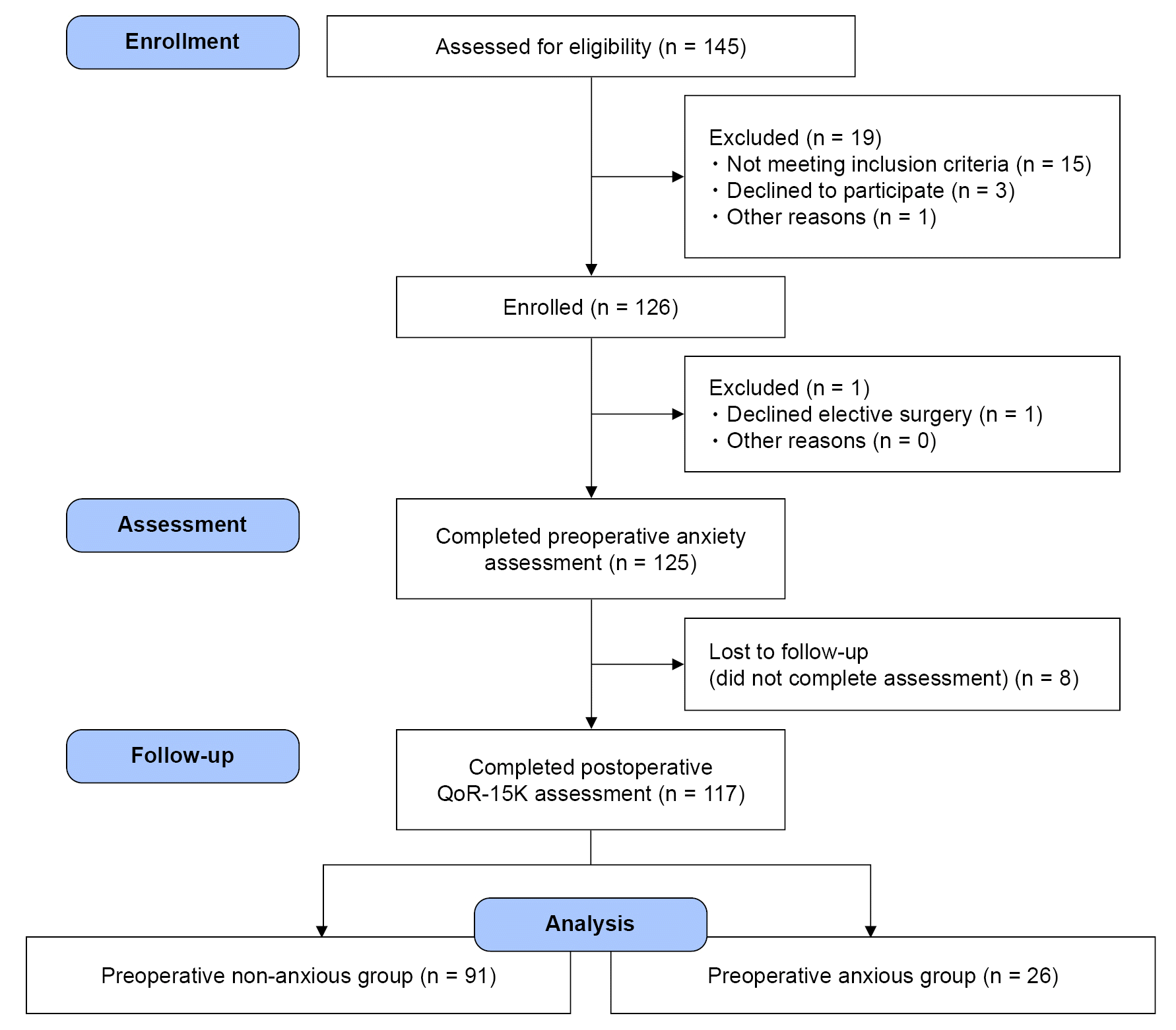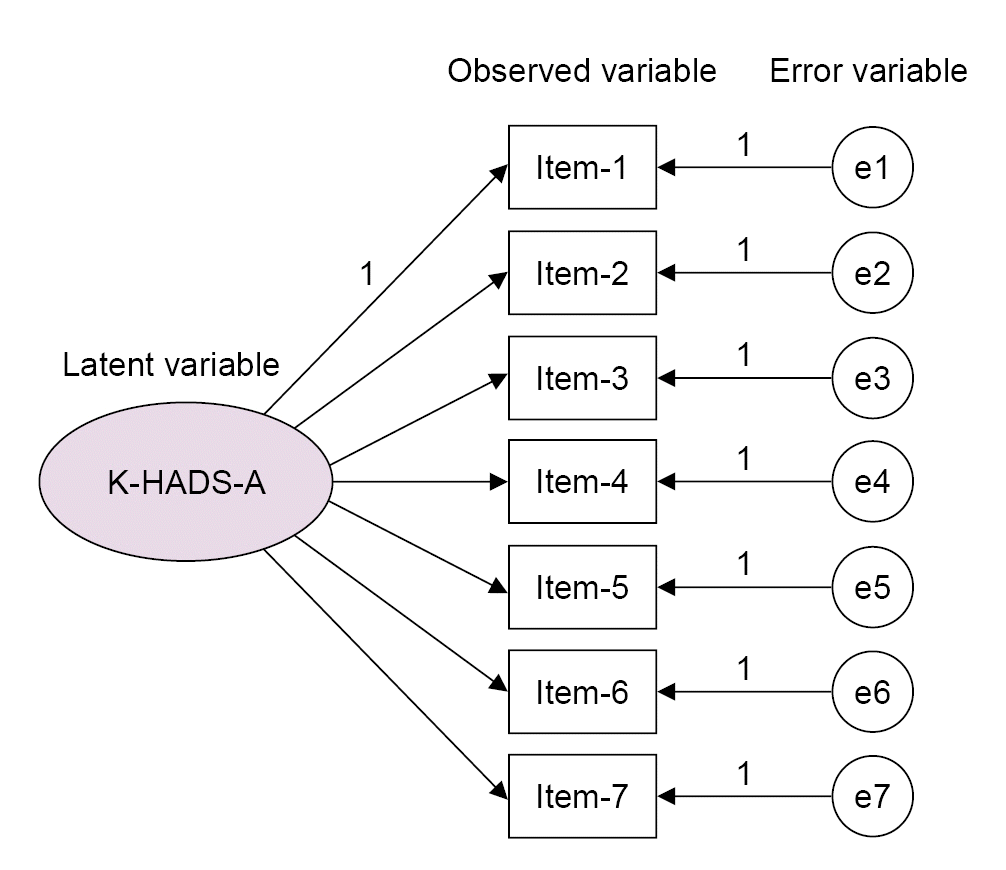Abstract
Background
Methods
Results
Notes
DATA AVAILABILITY STATEMENT
The datasets generated during and/or analyzed during the current study are available from the corresponding author on reasonable request.
AUTHOR CONTRIBUTIONS
Conceptualization: Dong-Chan Kim. Data curation: Jeongmin Oh, Jieun Jang. Formal analysis: Minjong Ki, Hyo Hyun Yoo. Methodology: Minjong Ki, Dong-Chan Kim. Visualization: Minjong Ki. Writing - original draft: Minjong Ki. Writing - review & editing: Dong-Chan Kim. Investigation: Seon Woo You, Jeongmin Oh. Software: Seon Woo You. Validation: Minjong Ki, Hyo Hyun Yoo.
REFERENCES
Fig. 1.

Fig. 2.

Table 1.
Table 2.
| Index | Value |
|---|---|
| χ2 | 48.688 |
| df | 14 |
| χ2/df | 3.48 |
| RMSEA (90% CI) | 0.146 (0.103, 0.192) |
| SRMR | 0.0614 |
| GFI | 0.894 |
| IFI | 0.905 |
| CFI | 0.903 |
| TLI | 0.855 |
| NFI | 0.872 |
K-HADS-A: the anxiety subscale of the Hospital Anxiety and Depression Scale for Koreans, χ2: Chi-square, df: degree of freedom, χ2/df: the ratio of chi-square to degrees of freedom, RMSEA: Root Mean Square of Error Approximation, CI: confidence interval, SRMR: Standardized Root Mean Square Residual, GFI: Goodness-of-fit index, IFI: incremental fit index, CFI: comparative fit index, TLI: Tucker-Lewis index, NFI: normed fit index. χ2 statistic for K-HADS-A is significant at P < 0.001.
Table 3.
| QoR-15K | Non-anxious group (n = 91) | Anxious group* (n = 26) | P value |
|---|---|---|---|
| POD 1 | |||
| Global QoR-15K score | 108.85 ± 26.54 | 96.77 ± 25.88 | 0.042 |
| Physical comfort | 36.46 ± 11.13 | 32.85 ± 9.40 | 0.134 |
| Emotional state | 31.43 ± 8.35 | 26.73 ± 11.24 | 0.021 |
| Psychological support | 17.35 ± 3.61 | 15.88 ± 4.08 | 0.078 |
| Physical independence | 12.65 ± 6.37 | 11.31 ± 5.67 | 0.335 |
| Pain | 10.95 ± 4.65 | 10.00 ± 4.36 | 0.351 |
| Mental well-being | 48.78 ± 11.13 | 42.62 ± 13.03 | 0.018 |
| Physical well-being | 60.07 ± 17.22 | 54.15 ± 15.77 | 0.120 |
| POD 7 | |||
| Global QoR-15K score | 127.55 ± 18.94 | 106.58 ± 29.49 | 0.002 |
| Physical comfort | 44.45 ± 6.83 | 37.54 ± 10.78 | 0.004 |
| Emotional state | 34.25 ± 6.42 | 26.96 ± 9.85 | 0.001 |
| Psychological support | 17.62 ± 3.47 | 15.81 ± 4.98 | 0.092 |
| Physical independence | 15.66 ± 4.49 | 13.81 ± 5.54 | 0.127 |
| Pain | 15.57 ± 4.06 | 12.46 ± 4.79 | 0.001 |
| Mental well-being | 51.87 ± 8.15 | 42.77 ± 13.49 | 0.003 |
| Physical well-being | 75.68 ± 12.30 | 63.81 ± 17.45 | 0.003 |




 PDF
PDF Citation
Citation Print
Print



 XML Download
XML Download